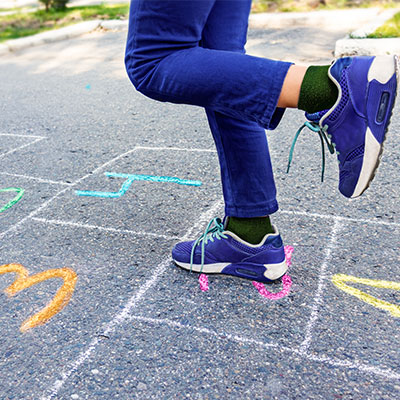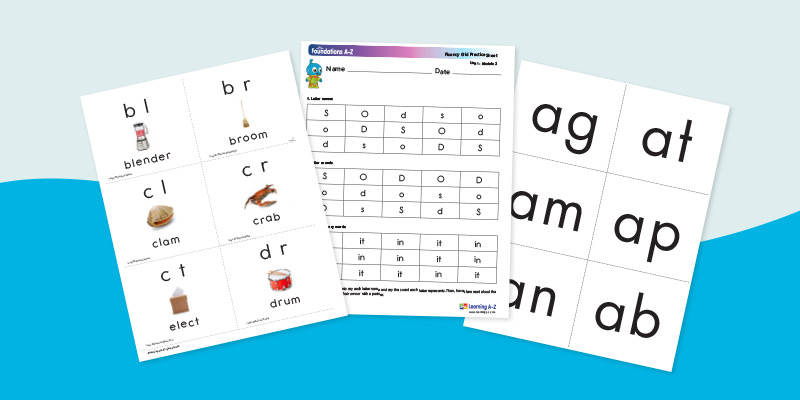Phonics is a crucial part of early literacy, helping students understand the relationship between letters and sounds to set a foundation for becoming proficient readers and writers. Students must also develop their phonological awareness skills, including the smaller subset of phonemic awareness skills. To develop phonemic awareness, students need to hear, identify, and play with individual sounds in words, which makes learning to read and spell much easier as the phonology and orthography processes in the brain form those connections. Phonics worksheets and games are an excellent way to hone these skills.
Using engaging and multimodal methods to teach phonics has many benefits. Of course, students are more likely to stay motivated and interested when they're having fun. These activities often involve movement, hands-on learning, and collaboration with peers, which can help reinforce phonics skills in a memorable way. Fun phonics activities are a great way to fortify your reading and vocabulary lessons.
Here are 20 phonics activities and links to resources in Foundations A-Z®, Raz-Plus®, and Reading A-Z® to help teachers incorporate them into their literacy instruction. Details on how to start a free trial are at the end of the article.
1. Bingo
Create and print sheets with words, letters, or patterns in a grid. Call out sounds or words and have the students mark off the matching square. Students can win in different ways, such as marking off a line, the corners, or the whole sheet.
- Fluency grid practice sheets in Foundations A-Z
- Alphabet Bingo in Raz-Plus/Reading A-Z
- Vowel Patterns Bingo in Raz-Plus
2. Hopscotch
Use tape or chalk to lay out a hopscotch grid. Place word cards with targeted phonics patterns in the squares and have children call out the words as they land in each square.

3. Word Pull
To create this activity, you'll need paper towel tubes and paint stirrers. Write beginning letter sounds on the stirrers and put ending chunks on the tubes. Students can move the stirrers in and out of the tubes to practice different words.
4. Simon Says
This is one of the best phonics games for the classroom. Give each student a few cards with letters and then provide instructions like, "Stand on one foot if you have the letter B."
5. I Spy
Hold up a letter card (such as “m”) and say, "I spy with my little eye, something that starts with 'm.'" Have the students take turns guessing.
6. Letter Labels
Post images of objects around the room and give students sticky notes with letters written on them. Have the students place the sticky note with the beginning letter of each object on that image. For instance, the sticky note with a "b" would go on the image of a bat. Repeat the game, but have children place the sticky notes that match the final letter of each object—the letter "t" in the case of "bat."
- Image cards for Foundations A-Z
- Grapheme cards Foundations A-Z
- Picture cards in Raz-Plus/Reading A-Z
- Letter cards Raz-Plus/Reading A-Z
- Picture flashcards in each Alphabet Book in Raz-Plus/Reading A-Z
7. Ping-Pong Phonics
Write letter blends on plastic cups. Have the students bounce a ping pong ball into a cup and then pronounce a word beginning with that letter blend.
8. Magic Spoons
Write ending patterns of words on the back of plastic spoons. Write the beginning letters on paper and have students move the spoon around the page to create different words. As a companion exercise, write the beginning patterns on the spoons and the ending patterns on a paper.
- Grapheme cards in Foundations A-Z
- Letter cards in Raz-Plus/Reading A-Z
- Phonogram flashcards in Raz-Plus/Reading A-Z
9. Go Fish
Make cards with target letters or patterns, like vowel teams, digraphs, or capital/lowercase letters. Put the students into groups of two or three and give each student a certain number of cards. Have them take turns asking for matches like "Do you have a card with the vowel team 'oo' on it?" If the student doesn't, they say, "Go fish," and the original student picks a card from the pile.
10. Spell-Off
Split students into small groups and give each group the same set of letter cards (for example, a, g, d, h, i, r, l, u). Set a timer and have each group write as many words as possible using the letters on the cards. Once the timer goes off, have each group read and spell the words they found. The group with the most correctly spelled words wins.
11. Beginning Sounds Chart
Other easy phonics worksheets to create include beginning sounds charts. Create a grid and then place a letter or letter blend in each section, along with a matching image. Students can review the beginning sounds during transition times.
- Image cards in Foundations A-Z
- Grapheme cards in Foundations A-Z
- Picture cards in Raz-Plus/Reading A-Z
- Letter cards in Raz-Plus/Reading A-Z

12. Slap the Sounds
Give each student a flyswatter and various letter cards. As you provide words, have the student slap the matching letters with their flyswatters, saying the letters as they go.
13. Sylla-Bee
Bring a small group of students up and give each a letter card. Have them stand in order to spell a word using the letters. Give another student a card containing a slash, and have the remaining students tell that student where to stand to break the word into two syllables.
14. Pocket Charts
Place a target pattern or sound in the pocket chart and have students sort cards to match the sound or pattern.
- Word sorts in Foundations A-Z
- Sounds sorts in Raz-Plus/Reading A-Z
- Letter sorts in Raz-Plus/Reading A-Z
15. Memory Game
Match words or blends on cards and lay them out in a grid face down. Have students pick two cards to see if they match, turning them back over if they don't.
16. Boxing Syllables
Here's another excellent phonics worksheet. Print a series of two-syllable words (like lemon, model, visit, and topic) on a paper and have the students draw a box around the closed syllable in each word. For a more challenging exercise, include words with open syllables, like baby and hero.
17. Flash Card Race
Print or write high-frequency words on flashcard sets, giving each student a set. Then, say a word and have the students race to see who can hold up the matching flashcard first.
- High-frequency word flash cards in Foundations A-Z
- Most common words flashcards in Raz-Plus/Reading A-Z
18. Sorting Syllables
Create a chart with a label for all known syllable types. Let students pick a syllable card from a deck, say the syllable, and write it under the appropriate label.
- Words sorts in Foundations A-Z 1
- Words sorts in Foundations A-Z 2
- Words sorts in Foundations A-Z 3
- Syllable cards in Raz-Plus/Reading A-Z
19. Digraph Scavenger Hunt
Number images of words that begin with digraphs and hang them around the room. Give the students phonics worksheets that have the numbers listed with various digraphs following each. The goal is for each student to mark the correct digraph. For instance, if the first image is of a spool, the students would circle the "sh" next to the number one.
20. Syllable Construction
Give students beginning syllables like tap, li, ri, slip, bid, sli, hop, strip, and ho. Have them create words by adding one of two ending syllables (+ding or +ed). Ask students to sort the words by whether the first syllable has a short or long vowel sound.
- Syllable cards in Foundations A-Z
- Syllable Cards in Raz-Plus/Reading A-Z 1
- Syllable Cards in Raz-Plus/Reading A-Z 2
Phonics Anchor Charts
To support these activities, hang phonics anchor charts around your classroom as a resource for students.
Charts in Foundations A-Z:
- Initial consonant blends chart
- Final consonant blends chart
- Phoneme/grapheme alphabet chart
- Phoneme/grapheme consonant digraphs and trigraphs chart
- Phoneme/grapheme vowel teams chart
See How Learning A-Z Can Support You in the Classroom
If you’re not a subscriber, start a free trial of Foundations A-Z, Raz-Plus, and/or Reading A-Z with no credit card required.
Frequently Asked Questions About Phonics Worksheets and Games
Here are some common questions about phonics games and worksheets.
How Do Phonics Games Help Students Learn to Read?
Phonics games make learning to read fun and engaging. By turning phonics practice into a game, children are more motivated to participate and learn. These games often involve repetition and practice of critical phonics skills, helping children better understand and remember the relationship between letters and sounds.
Can Phonics Worksheets Be Used at Home?
Absolutely! Phonics worksheets are perfect for at-home practice. Parents can use these worksheets to reinforce what their children learn in school. They are easy to use and can be a fun way to spend time learning together.
What Age Groups Are Phonics Worksheets and Games Suitable For?
Phonics games and worksheets are typically designed for young learners in Pre-K to 2nd grade. However, they can be adapted for older children who may need extra practice with phonics skills.
Order Now to Enhance Your Literacy Lessons
Now that you're familiar with some phonics worksheets and games, you're ready for the next step. Learning A-Z provides digital solutions that support literacy instruction. We empower teachers and equip students to succeed. Order today and unlock the full potential of your literacy lessons with Learning A-Z!


